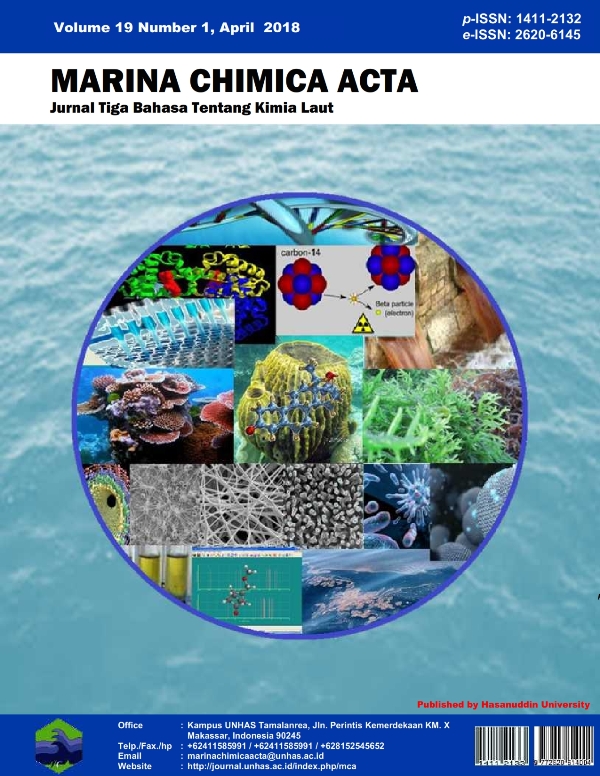LIGNIN AND CARBON ISOTOPES COMPOSITION OF SUSPENDED PARTICULATES BY CAPILLARY GAS CHROMATOGRAPHY OF CUPRIC OXIDE OXIDATION PRODUCTS
Abstract
Lignin are high molecular weight phenolic polymers that occur as major constituents of vascular plants. As a result of their natural abundance, wide distribution, and resistance to microbial degradation, lignin are also commonly found in soil and sedimentary organic matter. The aim of this study was to identify the contribution of lignin to the suspended particulate fraction in the Losari Beach and Lae-lae Island, where indicate highly degraded lignin materials. Lignin was characterized by oxidative degradation, cupric oxide being chosen as the most suitable oxydizing agent to produce simple lignin-derived phenols that are extracted with hexane and analyzed by capillary gas chromatography on fused silica columns, provides the high sensitivity and precision required for the identification and quantitation of trace levels of lignin in seawater. A suite of up to 8 phenols is produced that reflects the relative concentration and plant tissue sources of lignin present in the suspended material.
References
Benner, R., Kaiser, K., 2011. Biological and photochemical transformations of amino acids and lignin phenols in riverine dissolved organic matter. Biogeochemistry 102, 209-222.
` Crow, S.E., Lajtha, K., Filley, T.R., Swanston, C.W., Bowden, R.D., Caldwell, B.A., 2009. Sources of plant-derived carbon and stability of organic matter in soil: implications for global change. Global Change Biology 15, 2003-2019.
Culp R. (2012) Compound specific radiocarbon content of lignin oxidation products from the Altamaha river and Coastal Georgia. Nucl. Instr. Meth. B,
Dittmar T, Lara RJ.Molecular evidence for lignin degradation in sulphate-reducing mangrove sediments (Amazonia, Brazil). Geochim Cosmochim Acta 2001;65(9):1417 –1428.
Drenzek N.J., Montluc_on D.B., Yunker M.B., Macdonald R.W and Eglinton T (2007) Constraints on the origin of sedimentary organic carbon in the Beaufort Sea from coupled molecular 13C and 14C measurements. Mar. Chem. 103, 146–162.
Goñi,M. A., and K. A. Thomas. 2000. Sources and transformations of organic matter in surface soils and sediments from a tidal estuary (North Inlet, South Carolina, U.S.A). Estuaries 23: 548–564.
Gordon, E.S., Goñi, M.A., 2003. Sources and distribution of terrigenous organic matter delivered by the Atchafalaya River to sediments in the northern Gulf of Mexico. Geochimica Et Cosmochimica Acta 67 (13), 2359–2375.
Gustafsson O¨ ., van Dongen B. E., Vonk J. E., Dudarev O. V. and Semiletov I. P. (2011) Widespread release of old carbon across the Siberian Arctic echoed by its large rivers. Biogeosciences 8, 1737–1743.
Hansell, D.A., Carlson, C.A., 2001, Biogeochemistry of Total Organis Carbon and Nitrogen in the Sargasso Sea: Control by Convective Overtum, Deep Sea Res. Pt. II, 48(8-9), 1649-1667.
Hedges, J.I., Ertel, J.R., 1982. Characterization of lignin by gas capillary chromatography of cupric oxide oxidation products. Analytical Chemistry 54, 174–178.
Hedges, J.I., Clark, W.A., Quay, P.D., Richey, J.E., Devol, A.H., Santos, U.M., 1986. Compositions and fluxes of particulate organic material in the Amazon River.Limnology and Oceanography 31, 717–738.
Hernes, P.J., Benner, R., 2006. Terrigenous organic matter sources and reactivity in the North Atlantic Ocean and a comparison to the Arctic and Pacific oceans. Marine Chemistry 100, 66–79.
Hernes, P.J., Robinson, A.C., Aufdenkampe, A.K., 2007. Fractionation of lignin during leaching and sorption and implications for organic matter ‘‘freshness’’. Geophysical Research Letters 34, L17401. doi:10.1029/2007GL031017.
Hyodo F., Kuwae M., Sasaki N., Hayashi R., Makino W., Kusaka S., Tsugeki N.K., Ishida S., Ohtsuki H., Omoto K., Urabe J. (2017). Variations in lignin-derived phenols in sediments of Japanese lakes over the last century and their reation to watershed vegetation. Organic Geochemistry 103. 125-135
Jex, C.N., Pate, G.H., Blyth, A.J., Spencer, R.G., Hernes, P.J., Khan, S.J., Baker, A., 2014. Lignin biogeochemistry: from modern processes to Quaternary Archives. Quaternary Science Reviews 87. 46-59.
Loh, P.S., Chen, C.A., Anshari, G.Z., Wang, J.T., Lou, J.Y., Wang, S.L., 2012. A comprehensive survey of lignin geochemistry in the sedimentary organic matter along the Kapuas River (West Kalimantan, Indonesia).
Louchouarn, P., Opsahl, S., Benner, R., 2000. Isolation and quantification of dissolved lignin from natural waters using solid-phase extraction and GC/MS. Analytical Chemistry 72, 2780–2787.
May, C.L, Koseff, J.R., Kucas, L.V., Cloem, J.E., Schoellhamer, D.H., 2003. Effects of Spatial and Temporal Variability of Turbidy on Phytoplankton Blooms. Mar. Ecol. Prog. Ser. 254, 111-128.
Nagao, et al., 2010. Carbon Isotopes and Lignin composition of POC in a small river in Bekanbeushi Moor, northern Japan. Nuclear Instruments and Methods in Physics Research B 268, 1098-1101.
Novo-Uzal, E., Pomar, F., Gómez Ros, L.V., Espiñeira, J.M., Ros Barceló, A., 2012.Evolutionary history of lignins. In: Lise, J., Catherine, L. (Eds.), Advances in Botanical Research. Academic Press, pp. 309–350 (Chapter 9).
Opsahl, S. and Benner R., 1999. Major flux of terrigenous dissolved organic matter through the Arctic Ocean. Limnol. Oceanogr., 44(8), 2017–2023.
Orem, W.H., Colman, S.M., Lerch, H.E., 1997. Lignin phenols in sediments of Lake Baikal, Siberia: application to paleoenvironmental studies. Organic Geochemistry 27, 153–172.
Otto A. and Simpson M. J. (2005) Degradation and preservation of vascular plant-derived biomarkers in grassland and forest soils from western Canada. Biogeochemistry 74, 377–409.
Otto, A., Simpson, M., 2006. Evaluation of CuO oxidation parameters for determining the sources and stage of lignin degradation in soil. Biogeochemistry 80, 121-142.
Sarkar. A, Timothy R. Filley, S. Bera., 2015. Carbon isotopic composition of lignin biomarkers: Evidence of grassland over the Gangetic plain during LGM. Quaternary International 355. 194-201.
Spencer, R.G.M., Aiken. G.R., Dyda, R.Y. Butler, K.D., Bergamaschi, B.A., Hernes, P.J., 2010. Comparison of XAD with other dissolved lignin isolation techniques and a compilation of analytical improvements for the

